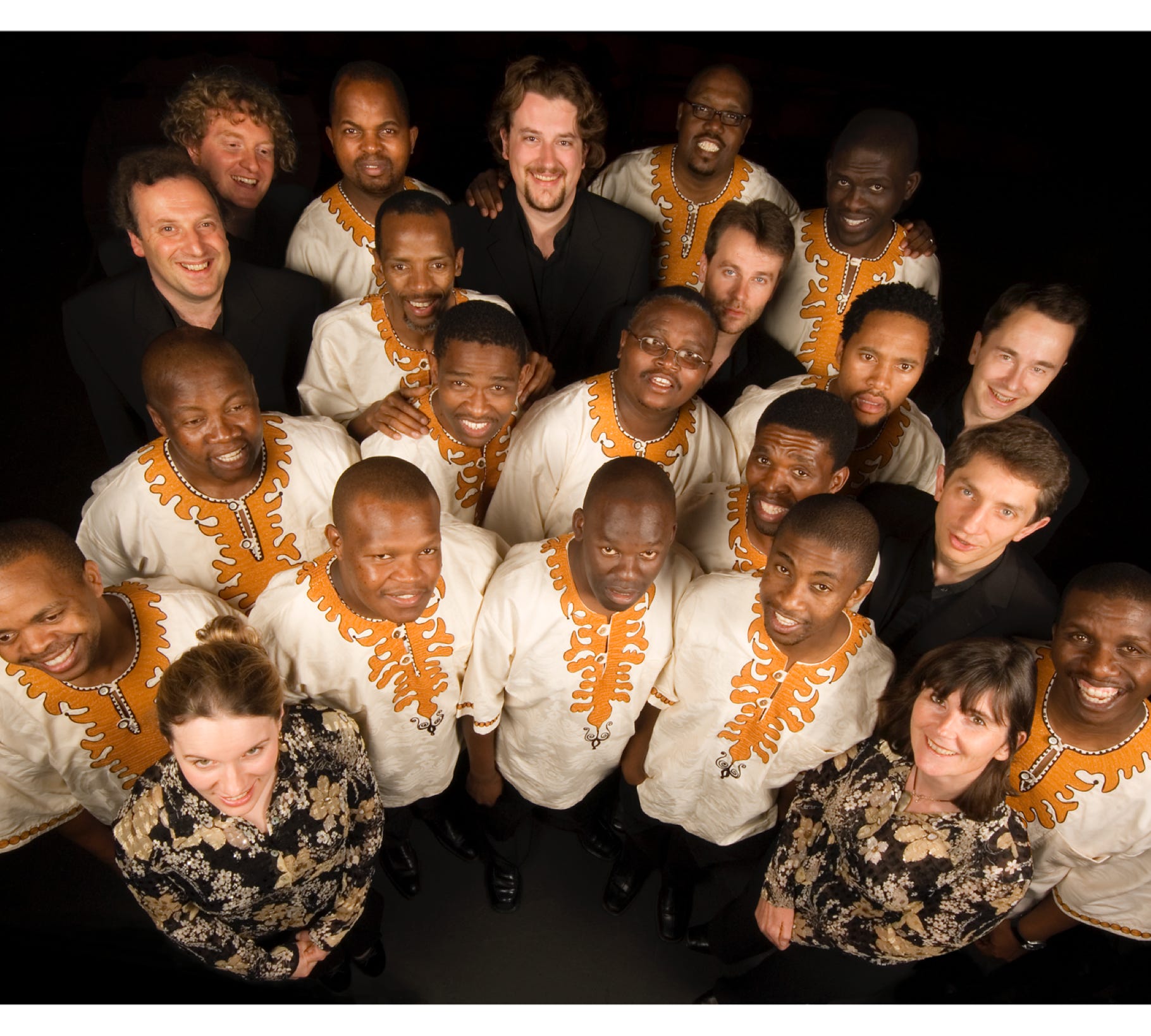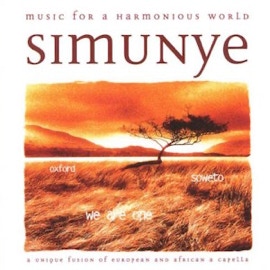First meeting: Funda Arts Centre, Soweto April 1995

SIMUNYE
WARNER MUSIC
1997
In 1997 two young vocal groups, one from Soweto and one from Oxford, spent two weeks together near Johannesburg to make this CD: for both it was a life-changing experience.
FEATURING:
Dlamini/R.Williams - Ah Robyn
Koapeng/R.Williams - Khutsho
R.Williams/Machaut - Douce Dame jolie


Bristol 2006
Simunye
Documentary from 2006 UK re-union tour
This clip features Ah Robyn, a favourite from the collaboration
4:34
TRACK NOTES
Trad. South African – eGolgotha (at Golgotha)
South Africans of almost all backgrounds sing hymns, but African hymnody is immediately identifiable through its robust voice production, typically African call-and-response figures, ‘blue’ notes and undeniable swing. The SDASA Chorale regards this popular hymn as one of its signature tunes.
William Cornyshe (d.1523) arr. SDASA Chorale / Roderick Williams – Ah Robin
In many ways, this piece marked the start of the creative relationship that ultimately resulted in the recording of this album. After hearing I Fagiolini sing this rather hypnotic 16th-century English round, the SDASA Chorale improvised its own lover’s lament in the style of traditional Zulu chant and then superimposed it on the original. Bheka, who chants the lament, says that “somewhere, somehow, there are chords in the English piece that are similar to Zulu traditional music.” Tracing such unexpected points of convergence became a highly stimulating aspect of the exchange project.
Mokale Koapeng (b.1963) / Roderick Williams (b.1965) – Khutsho
Mokale composed this heartfelt chant for peace in 1988, after years of intense political oppression and resistance in South Africa with no end in sight. When he introduced the piece during one of the first sessions that the two groups spent together, Roddy was moved to write a part for I Fagiolini that would combine Mokale’s piece with another chant for peace with a text from the heart of the Western liturgy, the ‘Agnus Dei’.
Monkitsi Seoketsa (b.1966) – U Jehova
Monkitsi is a pastor in the Seventh Day Adventist church and a composer of marvellous contemporary African church music. The SDASA Chorale has been singing this setting of Psalm 23 for some years now, and everywhere we went during the exchange project, the younger members of the congregation recognized it, waved their hands and joined in. I Fagiolini impressed everyone by arriving in South Africa having learned the hymn in Zulu, and so were invited to sing the opening verse alone – always a surprise for the congregation.
Monkitsi Seoketsa – Dumisa (Praise)
Monkitsi says that he composed this praise song “to give thanks; thanks for, amongst so many other things, the opportunity of collaborating with I Fagiolini.” The almost understated choral backing and the soloist’s impassioned vocals are masterfully combined in a simple and sincere statement of faith.
Orlando Gibbons (1583-1625) / Roderick Williams – O clap your hands
Having spent time listening to recordings of the SDASA Chorale before coming to South Africa, Roddy had the ambitious idea of combining African hymnody with Gibbons’ lively eight-part motet setting of Psalm 47. This was a piece that took the SDASA Chorale deep into unfamiliar musical territory, but they rose to the occasion admirably and affirmed the Psalmists’ claim: “God is gone up with a merry noise.”
Mokale Koapeng – Kgosietsile (Kingdom Come)
Perhaps the most eclectic of the SDASA Chorale’s resident composers, Mokale combines his interest in international gospel and jazz styles with a deep love of indigenous African music. He has based this swinging setting of the Lord’s Prayer on a shifting whole-tone bass pattern that is typical of traditional Xhosa music. Above this, he has written a sophisticated blend of parts that exploits the respective vocal idioms of I Fagiolini and the SDASA Chorale.
Trad. Cornish – The trees they grow so high
Although the sacred music of Britain and South Africa was central to this project, the composers within the two groups became increasingly interested in the folk roots of one another’s repertories. The purity of Carys’ performance of this bittersweet Cornish folksong clearly touched the SDASA Chorale when she sang it to them, and was reciprocated when I Fagiolini heard Bheka’s renditions of Zulu folksong.
Trad. Zulu arr. Dlamini (b.1965) – Kwa Zulu senzeni? (Kwa Zulu, what’s our crime?)
When we were preparing for the exchange project, I Fagiolini asked whether the SDASA Chorale knew of any traditional African chant which could be compared with Gregorian chant. Mokale immediately thought of Zulu amahubo music, and played us an example which had been recorded by the revered Princess Magogo (mother of Chief Buthelezi) in the 1970s. I Fagiolini was fascinated by the recording and Bheka decided to make an arrangement of the chant that could be sung by both groups.
Bheka says: “That tape took me back home and reminded me of the olden days, those terrible days, which saw the destruction of the Zulu nation.” It is indeed about the destruction of Shaka’s nation that Princess Magogo was singing, and so I asked Bheka why he wanted to sing the song with a group of English men and women, descendents of an empire that played such an active role in that process. “They liked the song,” he replied, “and I thought that it would be nice to sing it together; it would show unity. We can all share our fruit of life.”
Guillaume de Machaut (c.1300-1377) / Roderick Williams – Douce dame jolie
Everyone agreed that Machaut’s beautiful 14th-century melody would provide suitable material to work with, but no-one anticipated what Roddy wanted to do with it. In his own words: “I thought that, coming to Africa, it would be interesting to work with the types of processes that one finds in African drumming, and to relate this to contemporary ideas in so-called ‘pattern music’ which have become so widespread in Western music since the 1960s.”
Trad.South African – Vela! (Come!)
The two groups used this lively community song to introduce one another at their township performances. Meaning simply “Come, we want to see you, we are SDASA Chorale/I Fagiolini”, the unexpected “vela” sung by I Fagiolini aroused a lot of excitement from the audience.
John Sheppard (c.1515-c.1559) – Libera nos
Both groups are devoted fans of one another, but developed special preferences during their time together; the SDASA Chorale fell in love (musically!) with I Fagiolini’s sopranos and I Fagiolini became particularly attached to the SDASA Chorale’s bass voices. For this piece, the latter simply sang the plainchant-derived bass part of Sheppard’s sublime polyphony with I Fagiolini singing the upper voices.
Plainchant arr.Koapeng/I Fagiolini – Te lucis ante terminum
When I Fagiolini sent us a transcription of this timeless Gregorian melody, Mokale says that he set out to “approach the plainchant from a typically African perspective”. Both the Tswana text and the music could be described as a free paraphrase of the original.
Bheka Dlamani – Uma ngimbona Lomsindisi
One of the joys of the SDASA Chorale’s music is the variety of African styles that the group employs for use in church. This piece combines a gospel text with the delightful isicathamiya style of singing, which developed among male migrant workers in the mine compounds of South Africa during the first half of the 20th century (made internationally famous by the group Ladysmith Black Mambazo). A neo-traditional style that combines both indigenous and imported elements, it is accompanied by a whole repertoire of movements and gestures in live performance.
No Night There / Akukho Ubusuku Le!
English missionaries must have brought this Victorian hymn to South Africa some time during the 19th century, but since then, African Christians have made it something entirely their own. Here I Fagiolini sings the hymn in its original form, followed by the version which the members of the SDASA Chorale sing in church today.
Bheka Dlamani – Home
Bheka has written a moving gesture of hope, deliberately combining African and Western languages to express his vision of our common destination. He explains the passage which he composed for I Fagiolini’s sopranos towards the end of the piece as follows: “When you are very tired and hungry after a day of watching over the cattle in the fields and you turn to go home, then you can hear the songs of birds and sweet memories fill your mind. Then I think of the Home where we are going: definitely, sure.”
LISTEN
LISTEN
LISTEN
LISTEN
LISTEN
SABC Studios, April 1997
PROJECT INTRODUCTION
Oxford is a long way from Soweto, and the distance is not only to be measured in miles. Depending on from where you are looking, the two cities represent a lot of what is both best and worst about modern history. Simunye is a way of hearing that distance that draws on the spiritual traditions of both places and captures hints and echoes of a harmonious world.
During April 1997, I Fagiolini and the SDASA Chorale met in South Africa for an intensive cultural exchange project to compare, contrast and combine their respective musical worlds. Although European and African vocal musics have existed alongside one another in South Africa for hundreds of years, there has been very little creative interaction between them. Free exchange between the traditions which the two groups represent has only really become possible in the post-apartheid environment, and this project celebrates a kind of dialogue that was difficult to engage in previously.
At the same time, the meeting took place in an age of extended international contact, an era in which the boundaries which define countries, cultures and musical traditions are becoming increasingly permeable. In the process, the world is becoming more uniform, as former collective identities are absorbed within an expanding global culture. Much stands to be lost in this process; countless languages, songs and ways of envisioning the world. But something new is emerging as well, and Simunye represents one attempt to give it substance: the vision of a global community in which membership does not require sameness, and difference does not mean subservience.
During their exchange project in South Africa, I Fagiolini and the SDASA Chorale sang at African church services, performed together in township community halls and city theatres, and spent a lot of time in workshops, developing a joint repertoire. The album Simunye: Music for a Harmonious World was a document of their meeting, and contains recordings made at a variety of locations: during a live performance at a Soweto community hall, at a township church with the congregation in attendance, in the open African bush at the resort where the workshops were held, and at a leading Johannesburg studio.
Combining different musical traditions with integrity is never easy, but I Fagiolini and the SDASA Chorale have proven worthy of the challenge. The groups have a number of things in common; a similar youthful membership age, comparable histories of singing together (both groups have been in existence for about thirteen years) and an infectious love of different kinds of music. But this has never eclipsed their differences; each group has remained rooted in its own musical traditions, while establishing points of contact with another musical world. Much of the original exchange project simply centred on singing for one another and responding through music, rather than in words. That spirit has remained constant as the collaboration has developed.
Most of the music in the collective repertoire expresses religious themes, as a result of the strong historical links between British and South African church music and the SDASA Chorale’s base in congregational service. Some pieces are almost as old as the musical cultures in which they originate, while others were created for or with one another. Many are statements of faith, however broadly one wishes to define it. Folksong is another important source of inspiration, as is African hymnody. The intention was not primarily to create a new musical “fusion”, and where that happened it was the result of a spontaneous sparking of ideas between the resident composers of I Fagiolini and the SDASA Chorale. What were important aims were the meaningful sharing of one another’s music and one another’s worlds, and a desire to cross the unproductive gap between professional and community-based music-making.
Since their first meeting, I Fagiolini and the SDASA Chorale have performed to audiences across South Africa in a variety of settings. It is now with particular pleasure that they share the fruits of their collaboration with audiences elsewhere. Thank you to all those who, over the duration of this project, have made it possible for them to span this bridge of voices across the boundaries of race, nation and culture and, in a small way, to narrow the divisions within and between human hearts from which South Africa, and our world at large, continues to emerge.
BRETT PYPER
Project Co-ordinator
Atlanta, USA, February 1999